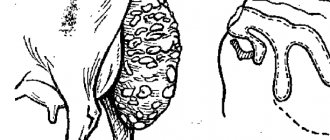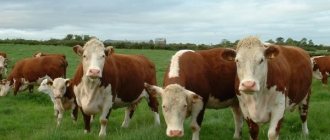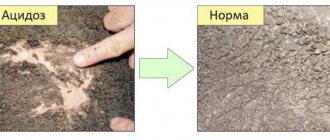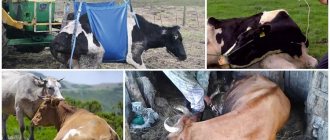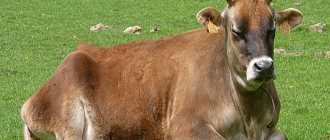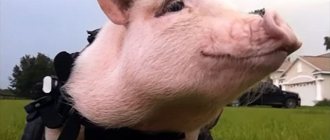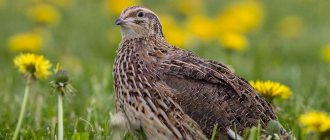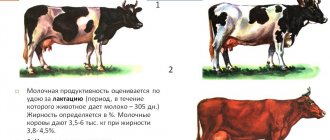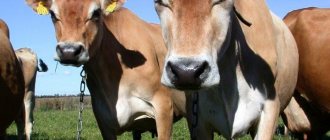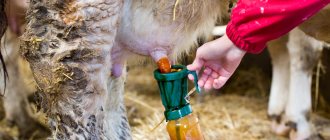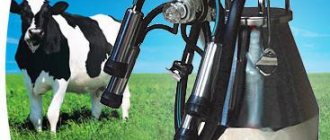Common diseases of cows after calving
Farmers are happy to wait for the cow to calve, because so much effort has been devoted to caring for the animal during the last 9 months of pregnancy. However, the appearance of offspring is often associated with troubles, and this is due to illness in cows after calving. Labor greatly weakens the cow, so any complications and illnesses that arise during the period after the birth of the calf are a reason to seek help from the veterinary service.
Cow after calving
After calving
When the most crucial moment is left behind - the calf is born, the cow and the newborn need help and care. What to do when a cow has calved:
- Tie the umbilical cord and cut it, and treat the end with iodine solution.
- Cleanse the newborn's body of mucus and amniotic fluid, paying special attention to the nose and mouth.
- Let the cow lick your baby.
- Wash the external genitalia from contamination.
- Clean up the stall.
- Give the animal something to drink.
- Give the calf a portion of colostrum.
All these actions are very important. Let's take a closer look at what it means to care for a calving cow and her offspring.
Care
First, you need to treat the genitals after calving, because the health of the cow depends on this. It is necessary to prepare a solution of potassium permanganate (potassium permanganate) at a concentration of 0.5%. The water should be warm. This product is used to thoroughly wash the vulva immediately after calving, as well as the limbs, belly and tail. The procedure is repeated after separation of the placenta, which occurs 3-6 hours after the birth of the offspring.
Attention! If the placenta does not separate after 8 hours, seek veterinary help. The placenta remaining inside will begin to decompose, and this is very dangerous for the life of the cow.
The cow should be given water to drink, because during the birth process she lost a lot of fluid. She is given no more than 5 liters of water, adding 2 tablespoons of salt to it. You can mix water with amniotic fluid collected during childbirth. This will help restore the salt balance in her body and speed up the separation of the placenta. After just an hour and a half, it is allowed to give clean water in unlimited quantities.
The cow needs to drink
Next is stall hygiene. The litter must be replaced with clean one, as the old one is contaminated with discharge from the uterus. Mucus, blood - all this is favorable soil for the proliferation of bacteria. A weakened animal and newborn are susceptible to infections.
Another important point is that the baby should drink colostrum in the first 2 hours of his life . This fluid, produced in the udder, contains a reserve of antibodies that will help strengthen the newborn's immune system. Particular attention should be paid to the nutrition of the calving cow.
Feeding
On the first day after the calf is born, the cow is offered good quality hay and oatmeal-based mash. The cow's diet is usually not changed, but is left as it was during pregnancy for 2-4 days.
Attention! A sudden change in diet and heavy feeding of concentrates in the first few days after birth can provoke a number of diseases.
Starting from day 4, the cow is offered root vegetables - beets, potatoes, carrots, and then concentrated feed is gradually introduced. This will stimulate milk production. Around the 10th day, the active milking phase begins, from this time the cow’s diet includes:
- 40% concentrates.
- 60% bulk feed.
Reference. If a cow produces a lot of milk so that she loses weight, the amount of concentrates is increased to 45-50%.
If a cow has udder swelling, farmers are in no hurry to switch her to a full ration for lactating cows until she has fully recovered.
Razdoy
Milk feeding is a very important factor in animal care. The productivity of the cow will depend on the correctness of the farmer’s actions in the post-calving period. Already on the day of calving, it is necessary to start milking the cow, although her udder still contains only colostrum for the calf. If this is not done, a stagnant process may develop, and then mastitis.
Manual dispensing is very important
It is more difficult to milk first-calf heifers; their udders often swell after birth, and the skin of their teats is not very elastic. It is important to be careful and not to frighten the cow with actions unfamiliar to it. First, the udder is washed with warm water, wiped with a soft, clean towel, then a short massage is done with the palms, moving from top to bottom. Such procedures are performed before each pumping 4-5 times a day with a time interval of 2.5-3 hours.
Around day 6, the milk becomes fattier and more nutritious, suitable for human consumption. At this time, you need to continue to actively milk the cow to increase its productivity . In the future, they switch to a three-time milking regime.
Attention! After calving, there is a high probability of developing mastitis. You need to be careful and note any changes in the animal’s well-being, evaluate the consistency of the milk and regularly inspect the udder for damage and lumps.
Characteristics and types of diseases
The period after the birth of a calf is often accompanied by various pathologies of cow health. Injuries received during childbirth occur, and inflammatory processes develop against the background of a decrease in the animal’s immunity. What complications occur most often in the period after calving:
- Uterine prolapse.
- Retention of placenta.
- Ruptures of the perineum and vagina.
- Layover.
- Infectious diseases.
Let's look at each condition separately to get some idea of the possible complications and their manifestations.
Uterine prolapse
Uterine prolapse after calving is a dangerous pathology that can lead to endometritis, infertility and even sepsis. The most common causes of uterine intussusception are:
- Poor living conditions during pregnancy.
- Lack of regular walking.
- Difficult birth.
- Poor nutrition during pregnancy.
- Tethered housing in a room with an adobe floor.
- Diseases.
Uterine prolapse, regardless of the reasons that provoked this condition, is always associated with a weakening of the walls of the reproductive organ - they become flabby. During calving, due to strong contractions, the uterus turns inside out and penetrates through the open canal of the cervix to the outside.
Cow genitals
A visual examination of the animal allows a diagnosis of uterine prolapse to be made. In this case, a pear-shaped organ protrudes from the cow’s vagina, which can hang down to the hock joint. This pathology requires qualified help. The uterus must be treated - rinsed with water and a solution of potassium permanganate, and then set in place. An important stage of treatment is to fix the reproductive organ inside to prevent its recurrence. To do this, take the following actions:
- A pessary is inserted into the vagina - a fixing device designed to hold the uterus inside.
- stitches are placed on the vulva;
- provide the animal with an inclined position (the croup is higher than the head).
A veterinarian or a person with experience who has repeatedly performed this procedure should perform repositioning of the cow’s uterus. To do this, he puts on gloves, clenches his hand into a fist, wraps it in cotton cloth and presses the prolapsed organ inside exactly in the center.
Attention! If there are necrotic lesions or other suspicious inclusions on the organ, the uterus must be removed. In this case, you cannot do without the help of a specialist.
Retention of placenta
Retained placenta is common in veterinary practice. After calving, the placenta should normally separate within 2-6 hours. Sometimes it happens a little later. But if the afterbirth does not come out within 8 hours after the calf is born, it is said to be detained. Why this condition is dangerous:
- The placental tissue will begin to decompose in the cow's uterus.
- The infection will spread to the walls of the uterus.
- Intoxication of the body will begin.
- The purulent contents will penetrate through the blood into other organs.
Retaining the placenta can be fatal
If the afterbirth remains inside for a long time, this is fraught with even more serious problems, including death. That is why you need to contact a veterinarian as early as possible, 8-10 hours after the end of labor in a cow.
Reference. The absence of an afterbirth does not always mean that it is delayed. Sometimes animals eat it.
How to determine that the placenta has not left the birth canal:
- When it is partially retained, tissue fragments are usually visible in the vagina.
- The cow is worried, straining, mooing.
- Loses appetite and looks lethargic.
- Within a day the temperature may rise.
- The vagina smells unpleasant and purulent discharge appears.
At the first symptoms of illness, you should inform your veterinarian. The afterbirth must be removed. For this purpose, hormonal agents are used that enhance uterine tone, various solutions that are poured into the cavity of the reproductive organ. If separation of the placenta cannot be achieved, mechanical extraction is resorted to. Then the uterine cavity is treated with antibacterial compounds. Treatment also includes injections of antibiotics to prevent the development of endometritis and sepsis.
Vaginal rupture
Vaginal rupture is another pathology after calving, which occurs quite often, especially in first-calf heifers. The main reasons for this complication:
- Prolonged labor.
- Rapid birth.
- Vaginal dryness.
- Incorrect presentation of the fetus.
- Large fruit.
- Unqualified calving assistance.
- Mechanical removal of the placenta.
Vaginal rupture is dangerous due to the cow's bleeding and the risk of infection in the open wound. In case of significant internal and external cracks in the perineum, the animal is given sutures and the wounds are regularly treated with disinfecting solutions and other means:
- Tannin.
- Potassium permanganate.
- Chamomile decoction.
- Ichthyol ointment.
- Antibacterial agents.
Small wounds located at the vaginal opening are lubricated with iodine. Preventive measures include proper management of labor, prevention of early labor, administration of antispasmodics, careful handling of the calf without the use of brute force, lubricating the vagina with sterile fat during calving.
Infections
Infectious diseases in cows during the post-calving period develop against the background of complications. If there are injuries in the uterus or vulva, pathogenic microflora can penetrate inside. The uterine environment is ideal for the growth of bacteria - it is warm and humid. As a result, endometritis may develop - inflammation of the endometrium. The body, weakened by labor, is unable to cope with pathogenic microflora.
Similarly, infection affects the uterus when the placenta is retained. Fragments of placental tissue located inside the reproductive organ begin to rot, microbes multiply and cause severe inflammation. Any infectious disease can be identified by its characteristic symptoms:
- General deterioration of the animal's condition.
- Increased body temperature.
- Lack of appetite.
- Signs of intoxication.
Treatment of infections involves the use of broad-spectrum antibiotics. The dosage and regimen are prescribed by the veterinarian, taking into account the condition of the animal, the severity of the development of the process, and the weight of the cow.
Examination of a cow by a veterinarian
Layover after calving
Often after the birth of a calf, farmers notice that the cow cannot get up on her feet. She constantly lies down, and if she tries to get up, she can’t, she falls. This condition is called laying after calving. What are its reasons:
- Fracture of the pelvic bones.
- Tendon strain in the pelvic area.
- Pinching of the sciatic nerve, as well as the obturator nerve.
- Inflammation of muscle fibers.
Retention of placenta
If after calving the placenta does not come out within a maximum of eight hours, then it is said to be retained. In most cases this happens for the following reasons:
- the uterus contracts weakly and does not push out the placenta. This may occur due to the animal's lack of vitamins;
- rare and irregular exercise during pregnancy. When an animal moves little, a lot of problems appear in the body;
- the muscles of the uterus are weak due to the presence of the disease;
- the placentas of the mother and fetus were united, again due to the presence of serious infections (brucellosis, trichomoniasis and others).
Already on the second day after birth, the afterbirth begins to decompose. This can lead to inflammation of the mucous membranes of the vagina, cervix, and general infection of the body. It is enough to react in time and remove the placenta promptly. Otherwise, infertility and other cow diseases may occur.
More on the topic: How to treat vaginal prolapse in a cow?
First, they try to force the uterus to contract with special drugs. Immunomodulators are also used. If the process does not start, they try to separate the afterbirth manually. This is done with clean hands after sanitizing and applying a moisturizing ointment.
You should be careful during the operation so that particles of the placenta do not remain in the womb. They can lead to rotting and inflammation. Then the uterine cavity and birth canal are washed with antibacterial solutions. Residues of drugs are removed from the cavity by pumping out. The procedure is repeated three days in a row.
When does a cow start walking after calving?
If the course of labor is favorable and there are no complications, the cow begins to show the first signs of heat already two to three weeks after calving. However, at this time her heat will be short. The explanation for this is very simple - the cow’s reproductive system has not yet recovered. The corpus luteum is not yet capable of reproducing full-fledged eggs.
It will take some time before the next insemination. It is necessary for the cow to rest and gain strength. Pregnancy is a difficult period during which the body is greatly depleted. The uterus should also return to normal, shrink to its natural size. The optimal time until the next mating is 45-60 days. However, in some cases it is worth waiting longer:
- If the cow is weakened.
- If complications arise during pregnancy and calving.
- If the animal has low fertility.
Under such circumstances, it is worth giving the cow more time to recover and starting insemination no earlier than 80-90 days after the previous calving.
High-quality care of the cow during pregnancy and proper preparation for calving are important factors that help avoid many problems and complications after the birth of the calf. Farmers should be attentive to their animals in order to recognize alarming symptoms in time and seek help from a veterinarian.
Feeding Basics
1.1 Composition of food supply
Dairy cattle bred in private household plots and small farms are fed:
- green food. This group of feeds includes pasture grass, including mown grass (for example, the so-called crushed green grass, widely used in farms with year-round animal housing systems), and vegetable tops. Green food is an invaluable source of biologically active substances. They contain a lot of vitamin E, which is important for the reproductive organs of females;
- roughage. This is hay (grass-legumes, forbs, alfalfa, etc.), straw (usually spring);
- succulent feed (silage, root crops, potatoes). These are sources of carbohydrates;
- concentrates. We are talking about feed, grain and bran - protein ingredients of diets. In private household plots it is cheaper to use flour from grain crops.
Pine feet, grass meal, molasses, BVMD, premixes and other additional sources of organic compounds and minerals are also used.
1.2 About the structure and composition of the diet
For the sake of fairness, it is worth considering the nuances of feeding a cow just before calving - two to three weeks before the calf is born. At this time, only high-quality feed is applicable. The animal is given hay, concentrates are excluded or reduced to 1 kg (it is better to give 500-600 g/day). Minimize the provision of succulent feed, as they increase the likelihood of mastitis, difficult calving, and postpartum complications.
Approximate structure of a cow's diet before calving:
- hay, straw – 16%;
- concentrates – 24%;
- silage – 60%.
As for the daily feed intake of a woman in labor, it depends on the time elapsed after the birth of the offspring:
- on the day of calving: oatmeal (about 5 l) + hay (4 kg) or pasture grass (9 kg);
- 2 days: pasture feed (up to 10 kg) or hay (4.5-5 kg) + mash (bucket);
- 3-4 days: a mixture including flaxseed meal, bran and oats (1.5 kg) + fodder beets (3 kg) + concentrates, for example, mixed feed (1 kg);
- 5-6 days: the same feed and in the same quantity. The exception is compound feed - about 1.5 kg;
- 7 days: the diet discussed above with a 2-kilogram daily norm of concentrates + silage, melons and other succulent feed.
Diseases of cows after calving: causes
If animals begin to behave unnaturally, symptoms and nutrition should be analyzed to determine the diagnosis. All mistakes made lead to reproductive disorders and metabolic disorders. The cow must be provided with sufficient nutrients, that is, provide the required amount of roughage and change the components of the feed ration as little as possible after the animal has become accustomed to receiving feed. Here are some metabolic disorders caused by nutritional errors.
Ketosis
Ketosis is one of the most important metabolic diseases. The main cause of this disease in cows after calving is malnutrition of animals, that is, a lack of carbohydrates in feed. To cover the deficit of carbohydrates in the body, the cow begins to use accumulated fat. As a result, there is the so-called incomplete combustion of fatty acids and an increase in the amount of ketone compounds.
This disease occurs especially:
- in highly productive cows that are in good condition, usually 10-60 days after calving;
- in older cows after the fourth and subsequent lactations.
Depending on the concentration of these compounds in the blood, milk, saliva, urine, ketosis can occur in subclinical (latent) or clinical (with pronounced symptoms of the disease). Apart from loss of milk quantity and quality, ketosis also causes many other complications. This is the reason for the decrease in cow productivity. Then childbirth with complications and retention of the placenta is observed, calves are more often stillborn, inflammation of the uterus occurs (dryness), and a longer period between walks occurs.
Preventing ketosis is based on a healthy, nutritious diet, including:
- providing the cow with enough feed, taking into account energy demand;
- adjusting the feed dose to the performance and genetic potential of each cow;
- avoiding sudden changes in food during feeding;
- do not feed low quality silage, especially those containing butyric acid;
- proper feeding of the cow during the drying period (use low energy intake during the first drying period, gradually introducing concentrate over 2-3 weeks before parturition);
- during the perinatal period, do not use ketogenic feeds containing simple sugars (sugar beets, sugar beets, molasses, beet silage);
- the use of preventive medications that regulate carbohydrate metabolism (for example, niacin, propylene glycol).
Postpartum paresis
This pathology is considered one of the most severe among postpartum diseases in cows. The female quickly becomes helpless due to the fact that her tongue, pharynx, digestive organs and limbs are paralyzed. The animal may even lose consciousness. This outcome occurs in highly productive cows with large weights.
More on the topic: Symptoms of zuboron in a cow and how to treat it
Paresis is associated with nutrition. In particular, a lack of glucose and calcium in the feed and overfeeding with concentrated food without alternating with juicy and rough foods.
An aggravating factor is the lack of walking:
- the cow's limbs are trembling, she lies down and does not get up;
- if the position is not critical, then the head is supported by weight, although the neck is tilted;
- in more severe cases, the cow lays its head on the chest wall and throws it back;
- the temperature drops by two to three degrees;
- the area near the horns is cool;
- the tongue may fall out;
- the animal closes its eyes and groans.
Treatment consists of regularly milking the milk so that it does not stagnate and go rancid in the udder. Then air is blown into the udder. At the same time, an injection of caffeine is given, the body is rubbed and the cow is warmed up.
A solution of calcium chloride and glucose is prescribed intravenously to restore strength. Vitamin D, minerals, and sweetened water are added to the feed. It is necessary to monitor bowel and bladder emptying. If something happens, help with catheters and enemas. While the cow is not getting up, provide her with warm bedding and prevent bedsores from appearing with massages and special medications.
Rumen acidosis
This is a painful process that involves a significant decrease in the pH of the rumen, causing destabilization of its functioning. A decrease in pH below 6.0 stops fermentation in the rumen and reduces the activity of cellulolytic bacteria. This means that the feed components are not completely used. Harvesting easily digestible carbohydrates produces large amounts of volatile fatty acids, which lowers rumen pH and inhibits the growth of cellulose-degrading bacteria.
A pH below 5.2 effectively removes all cellulolytic bacteria from the rumen.
Below pH 4.7, lactic acid bacteria develop, producing increasing amounts of lactic acid, the excess of which leads to immobilization of rumen motility, disappearance of microflora and cessation of fermentation processes.
The consequences of lowering rumen pH are:
- decreased milk production;
- reduction of fat content in milk;
- deterioration in reproduction rates;
- deterioration of hoof health;
- increase in the content of somatic cells in milk.
This manifests itself in reduced or diminished appetite, deterioration in the general condition of the animals, diarrhea, limb ulcers or laminitis. At the first symptoms of rumen acidosis, feed containing easily fermentable carbohydrates should be removed from the diet, while good quality meadow hay is provided. In severe cases of ruminal acidosis, veterinary intervention is necessary. However, prevention is most important to avoid pestilence.
The most important measures to protect against this disease are:
- avoid frequent and rapid feed changes,
- the use of transition periods when changing winter nutrition to summer and vice versa,
- the feed ration must contain a sufficient amount of structural carbohydrates, that is, unprocessed fiber (it must be at least 17% in the dry matter of the feed ration and at least 23% in the dry matter of the feed roughage),
- systematic introduction of cows to feed concentrate, especially during the last drying period and during the distribution period,
- dividing large doses of concentrated feed into several pastures (up to 2.5 - 3 kg per pasture),
- avoiding feeding excessively fragmented feeds,
- using a proper feeding method, i.e. not feeding concentrate and young green feed in the morning,
- avoid feeding too much acidic feed (beet silage, distillery) and containing easily fermentable sugars (molasses, sugar beet and fodder beet),
- use of rumen pH buffers (eg sodium bicarbonate).
Fixed herpes
Garter disease (hypomagnesemia) is characterized by decreased levels of magnesium in the blood and is usually associated with feeding animals on pasture.
Symptoms:
- decreased milk yield
- nervousness and muscle tremors.
In severe cases, the cow foams at the mouth, staggers, falls, and then dies.
The main reason is magnesium deficiency in the feed, which is associated with a small amount of dry matter and insufficient magnesium content in it with a low level of bioavailability.
Prevention methods: Increasing magnesium uptake by animals through careful husbandry and supplementary feed compounds containing this ingredient. To increase the level of magnesium in plants, it is recommended to apply fertilizers containing magnesium to the soil, as well as increase the proportion of legumes in the meadow. The grass tendril prevents the introduction of 100 g of magnesium oxide per day. Tetany can also be caused by stress, cold, wet weather, lack of wind protection, heat, lack of feed or poor handling of animals. Conversely, potash and slurry fertilizers should not be used on pastures in the spring before grazing.
Retained placenta after calving
The cow should expel the placenta within 8 hours of giving birth. Prolonged placement of the placenta can lead to loss of appetite, increased body temperature and decreased milk output. Halitosis is a symptom of fetal rot and inflammation of the uterus. Most often, retention of embryonic membranes is accompanied by
- miscarriages;
- complicated and double calvings;
- frequent pregnancy;
- low levels of oxytocin hormones;
- stress.
The cause of placental retention can also be microorganisms that cause inflammation of the genital tract. Feeding factors influence this disorder:
- abnormal energy levels in feed;
- mineral and vitamin deficiency (especially vitamins A and E).
Prevention of this disease in cows after calving is to prevent the cow from becoming fat at the end of lactation and drying out, and milking the cow immediately after giving birth causes the release of oxytocin into the blood,
How to conduct your first discharge
After giving birth, a cow's udder quickly fills with milk, so she needs to be milked regularly. The pause between this process should be no more than 9-10 hours. Milking should be done about 4 times a day. Any delays in milking can result in a reduction in milk supply of up to 2 liters per day. Before each milking it is necessary to do a massage, the rules of which are described above. The process should begin immediately after the nipples and udder swell.
Certain milking techniques must be followed. It is important to remember that a cow that has given birth cannot be milked with pinches. Such treatment can cause inflammation of the udder and a decrease in milk yield even in healthy cows. If you use this technique on a young heifer, the milk may disappear forever. The cow must be milked with fists, and the first streams must be milked in a separate bucket, because they contain germs. Read more in the article: “How to milk a cow after calving.”
Postpartum paralysis
Most commonly, birth paralysis is also called milk fever in cows between 5 and 10 years of age. Paralysis can occur just before, during, or immediately after childbirth (10 to 24 hours). This is a physiological disease that occurs as a result of disturbances in the metabolism of minerals, calcium and phosphorus during pregnancy.
Colostrum produced after birth contains large amounts of calcium and other minerals that meet the calf's needs for the above. Ingredients. Then there is an imbalance between the sudden demand for calcium associated with the onset of lactation and the ability to deliver it in dose and insufficient mobilization of calcium nutrition from bone stores.
Prevention requires proper balancing of the nutrient dose in terms of minerals during the drying period of cows, especially 2 to 3 weeks before scheduled calving. The difficulty is that the increase in demand for minerals as delivery approaches is not associated with greater consumption of mineral compounds (especially calcium) from the body or does not change their relative proportions.
Movement of the abomasum
After a difficult and complicated birth or excessive grinding of roughage (using compound feed) up to 4 weeks after birth, abomasum may occur. As milk production increases, the concentrate increases and the volume of roughage, especially hay and straw, decreases, which is the main reason for the digestion of rennet. Prevention is only proper nutrition during the drying period and immediately after birth, where the basis of feeding is the presence of long-fiber feed (hay, haylage, green feed) in the feed dose and a gradual change in the dose after calving.
Fat cow syndrome, aka fatty liver syndrome
The disease develops at the end of lactation when cows are fed high-energy feed. Excess of these feeds (especially hidden ones), in relation to roughage with a high starch content in dose, leads to a decrease in the fat content in milk. The conversion of energy from fat synthesis in milk fat deposits in tissues changes:
This is most common in drying cows with too rich a diet. The main symptoms of cow disease after calving are: sadness, loss of appetite, decreased body resistance after calving, which leads to paralysis, placental arrest, and delayed onset of the sexual cycle.
Prevention consists mainly of assessing the condition of cows in the herd, preventing excessive fatness at the end of lactation and during the drying period.
The owner comes to the rescue
A calving cow should be given maximum attention. After all, childbirth, although a natural process, requires a lot of effort and energy from the animal. At the same time, the cow becomes very susceptible to various types of infections. At this moment, her body is an open gate for them. And here again a loving owner must come to the rescue.
It is necessary to provide the cow with rest and light food - well-dried grass and oatmeal. A large amount of succulent feed after calving leads to inflammation of the udder. On day 4-5, you can gradually begin to increase vitamin-containing feed.
Allowing newborn calves to suckle from their mother's udder for the first two days will be beneficial, especially for first-time heifers. But then they should be fed from the nipple, and the cow should continue to be milked by hand so that the milk does not stagnate in any of the lobes. To avoid mastitis, it is also necessary to do preventive massage.
Diseases after calving in cows: symptoms and treatment
Calving is stressful for cows' bodies, and after pregnancy is resolved, queens experience health problems due to maternity complications. Paresis, placenta retention, damage to the genital apparatus and other diseases appear. This is often associated with unsatisfactory living and nutritional conditions, weak immunity, or lack of attention from the owner.
Cows often experience complications after calving.
Diseases of the herd affect its productivity and the health of the offspring. Timely detection and treatment will help the livestock return to its previous high levels.
Layover after calving
If the cow looks quite healthy after calving, willingly eats and does not show any suspicious signs, but cannot get up and stand, then we are talking about a pathology such as laying after calving. In this case, the animal can move any part of the body, but the backside begins to weaken due to a long stay in one place.
Postpartum retention is caused by muscle weakness of the animal.
The causes of the disease are as follows:
- The cow gave birth to a large fetus, which caused internal damage to the body - sprains in the pelvic joint, muscle injuries, disruption of the sciatic nerve.
- The birth was performed incorrectly, which resulted in the same injuries.
- Violation of diet before and during pregnancy.
[adsp-pro-4]
Treatment of pathology is complex:
- A clean bedding layer of 15-20 cm is spread under the animal.
- Every day the cow must be turned and placed on different sides, otherwise bedsores will form.
- The back sides should be massaged every day in a circular motion. During the procedure, substances that stimulate nervous activity (mustard or camphor alcohol) are used.
- Warming compresses should be placed on the lumbar and sacral area - mustard plasters or an ordinary heating pad are used.
The prevention of laying is the regular walking of a pregnant cow.
Since bearing a large calf is often accompanied by similar phenomena, it will be quite difficult to prevent laying in this case. However, in general, effective measures to prevent the disease are:
- balanced nutrition, especially during childbirth;
- constant walking of the animal.
Since lying down is often associated with weak muscles of the cow, it is necessary to completely level the floor in the barn, paying attention to the area where the animal rests - during prolonged standing on uneven ground, the muscles become overstrained and begin to weaken.
Refusal to rise
Sometimes a representative of the herd, having calved, does not get up on her own, and even if she gets up, she quickly lies down again (but does not lose consciousness, as with paresis). This occurs as a continuation of prenatal retention or occurs immediately after resolution of pregnancy. Causes of sudden postpartum retention, which occurs more often in cattle rather than goats or sheep, include:
- unbalanced diet during pregnancy and dry wood (which also causes paresis or retention of the placenta);
- long and difficult childbirth with damage to the pelvic bones;
- disorders of the nerve endings of the gluteal and sacrolumbar regions;
- rheumatic muscle phenomena.
When diagnosing a deposit, the veterinarian immediately rules out dislocations or fractures. If there are no complications, the animal recovers within 3-10 days. When complications arise:
- exhaustion;
- bedsores;
- gastrointestinal disorders (constipation);
- blood poisoning;
- prolapse of genital organs.
Septicemia
The disease mainly occurs due to trauma during childbirth. Streptococci or staphylococci, E. coli and other bacteria are involved.
Igor Nikolaev
auto RU
In addition to the lethargic state, the animal’s milk production process stops. You can milk a small amount of milk, but it will be blue or red in color. The cow tries to lie down, as if with paresis.
The difference between the pathology is the presence of a rash and bleeding from the mucous membranes. Blood may also be released in liquid stool. Sometimes there is no stool at all.
The disease can be identified thanks to the following signs:
- putrefactive discharge indicates acute septicemia;
- nothing happens around the wound. This means that the body does not react to bacteria, to the difficult process that has begun. In this case, there will be complications;
- blood pressure decreases greatly, the pulse becomes rapid and difficult to calculate;
- protein is found in the urine;
- Putrid fluid flows from the uterus, its walls are dense and thick;
- Rarely does an animal fall into a coma immediately, without obvious symptoms. Death is inevitable;
- The obvious difference is the temperature jumps. At first it rises sharply, then also falls. The result can be twofold: either recovery or death. The picture will become clearer in a matter of hours.
More on the topic: What are the features of Watussi bulls?
Therefore, treatment is useless if sepsis is expressed in a putrefactive course. The lifespan of a cow is measured in two to three days. When the situation is not so dire, measures are taken.
First of all, the wound is treated. Novocaine, broad-spectrum antibiotics are administered and antimicrobial drugs are used. Don't forget about heart remedies and to improve digestion.
Problems with afterbirth
Among cattle, placenta retention is most common after calving. This happens if it does not come out spontaneously after 6-8 hours. The membranes hang down to the hocks at the back, the animal strains. After a day, as a result of the delay, the afterbirth decomposes, which leads to further disorders (inflammation of the walls of the vagina and peritoneum, blood poisoning). Among the causes of the disease are:
- uterine muscle weakness, which occurs as a result of an unbalanced diet with a lack of vitamin and mineral elements;
- lack of movement during pregnancy;
- uterine disorders;
- connection of the embryonic and maternal placentas (for some diseases: brucellosis, endometritis).
Timely comprehensive treatment, which is aimed at increasing the body's resistance and uterine tone, will save the animal. At the beginning of the delay, use drugs that stimulate the separation of the placenta - ergot (in the form of an extract or injection), prozerin and sinestrol in solution. Their use will expel the remaining tissue inside. To prevent suppuration and sepsis during detention, inject penicillin, streptomycin or biomycin into the uterine cavity of cows (in proportions recommended by the doctor). For these purposes, white streptocide and norsulfazole are used.
If after the treatment carried out at an early stage the delay persists, then at the beginning of the second day after calving the cows undergo surgery.
The external and internal genital organs are pre-treated with disinfectants, the afterbirth is intercepted and twisted 1-2 times.
Normally, the placenta should come out a maximum of 8 hours after calving.
One to five liters of sodium chloride heated to 42 degrees in a 5 percent solution are injected into the space between it and the uterine mucosa through a rubber tube. Then the afterbirth is carefully separated from the uterine caruncles, starting with the nearest ones. Having completed the operation, the previously administered disinfectant solution is removed from the uterine cavity through the rectum.
Preventive measures for the disease - good nutrition, exercise in the fresh air, intramuscular injections of tetravit and trivitamin 10 ml. Glucose (40% solution) also helps to avoid frustration.
Feeding newborn calves
The calf should receive its first portion of mother's colostrum no later than an hour after birth. This activates the newborn’s digestive system: the functions of the stomach and intestines return to normal, the original feces are released and the intestines are populated with microflora. But if the first drinking of colostrum is late, the calf may begin to have digestive problems.
For the first 4-5 days after birth, calves are given colostrum four times a day, drinking 1.5-2 liters at a time. The intervals between watering should be equal. If the calf is kept with its mother, the cow must be supplemented after each feeding because the calf usually cannot suck all the colostrum completely.
Starting from day 5, calves should be given boiled salted water along with colostrum. Before drinking colostrum, and then 30-60 minutes after it.
From the 6-7th day, the calf is transferred to three times a day of watering.
Starting from 15-20 days from birth, healthy calves can be given dietary supplements (bran, grated carrots) and high-quality hay and allowed to go for walks on warm days.
Damage to the genital organs
Vaginal wall rupture
The reasons why vaginal rupture occurs are too strong pushing, atypical position of the calf, large fetal size (or multiple births). Sometimes the walls of the genital organs are damaged as a result of unprofessional obstetric care. Symptoms of the disease:
- for shallow injuries - local bleeding;
- with through perforation - complete destruction of the walls of the organ, prolapse of other internal organs (intestines, bladder) into the vaginal cavity.
The prognosis of the disease is often unfavorable for cows: their vagina narrows, which leads to infertility or subsequent problems during calving. As a treatment, tampons soaked in liquid preparations are inserted inside to stop bleeding and disinfect wounds. Washing the damaged organ is not allowed.
After a vaginal rupture, a cow rarely continues to give birth to calves.
Uterine prolapse
When the uterus prolapses, it is in an inverted position; after some time, cracks and swelling appear on the organ, the surface becomes inflamed and affected by necrosis. Disturbances appear after pregnancy has been resolved or a few hours later, with an enlarged cervix. Their reasons:
- prolonged strong attempts in cows, which do not stop even after calving;
- rapid labor;
- violation of content rules.
Treatment for this disease is rapid reduction to the original position. In this case, contact a veterinarian for help. After removing the afterbirth, the outer part is treated with potassium permanganate (diluted with water in a ratio of 1 to 10).
The animal is helped to take a position in which the rear is higher than the front. Then the uterus is carefully adjusted and its folds smoothed out.
In order to prevent the disease, the affected cows are positioned so that the front legs are lower than the hind legs, and additional stitches are applied.
To reduce the uterus, contact a veterinarian
Intoxication
At the end of calving, animals with weakened immune systems experience damage to the body as a result of toxic substances and pathogenic microbes from the uterus and reproductive system entering the blood. It also occurs as a consequence of damage to the birth canal. A sick animal weakens, loses appetite, and its temperature rises. Immobility sets in, and gastrointestinal disorders occur.
These diseases are characterized by an enlarged uterus, which reacts painfully to palpation and fills with fluid. The organ itself or its neck becomes inflamed. To treat a sick specimen, farmers use intramuscular injections of penicillin or streptomycin (dosage recommended by a veterinarian). Glucose diluted to 40% is given intravenously, 200-300 milliliters 2-3 times a day. At the same time, streptocide is used 5-10 times a day, biomycin and terramycin.
Livestock conditions are improved, they are fed a variety of balanced foods and are additionally given fish oil and vitamins.
Fish oil is a good prevention of intoxication
